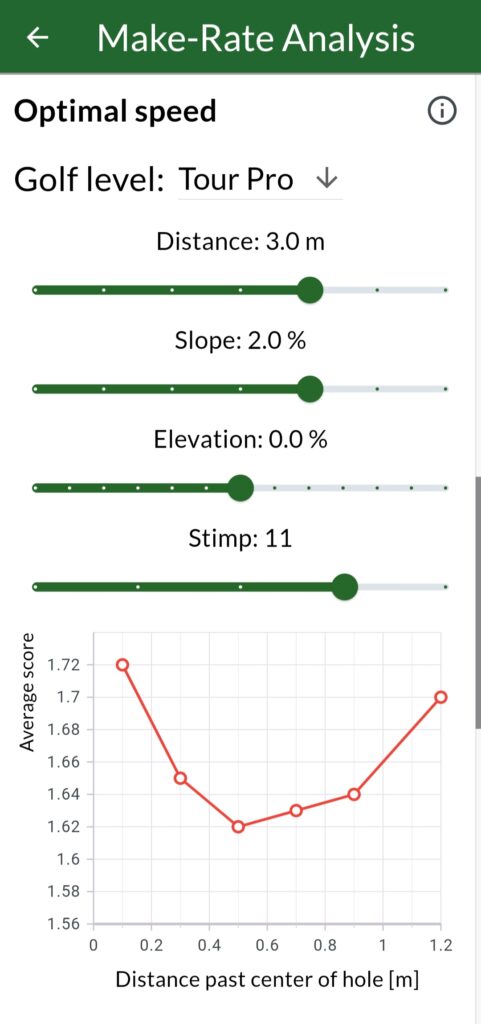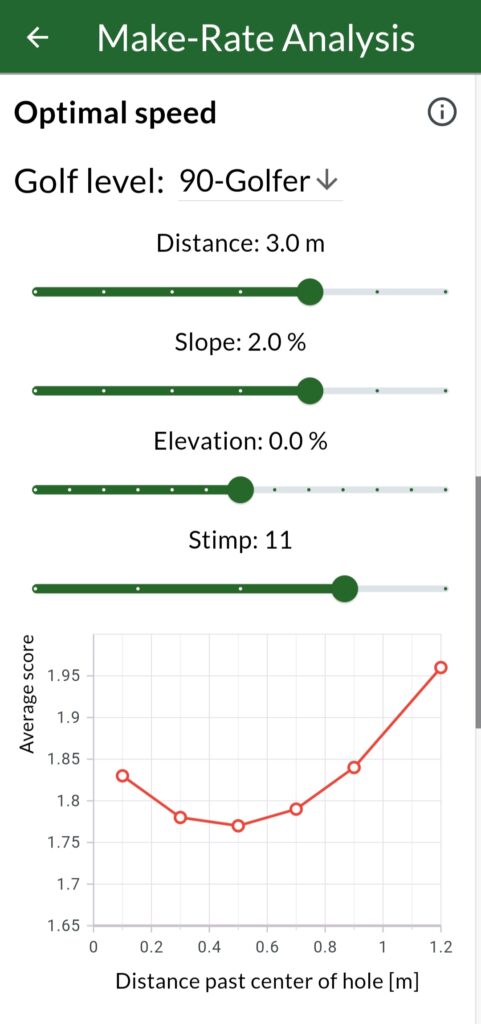By hitting putts with the optimal speed you will save shots each round. But what is the optimal speed and how many shots per round will you save with optimal speed? If you hit a putt with a slower speed the effective hole size increases but the risk of hitting putts short increases and the putt is more affected by green reading. If you instead hit a putt too firm, the effective hole size shrinks and the return putt becomes trickier.
To answer the 2 questions we will use the Putt Analyser in the tGAT app which has previously been discussed in the post What is the best way to improve your putting? Just as in that post, we will use the same standard deviation (SD) estimate for elite golfers.
| Putt category | Standard deviation (SD) |
| Start direction | 0.6° |
| Speed | 6% |
| Green reading | 0.45% |
To find the average score for a putt with our known SD values we also need to have an approximation for how well the return putt is hit. This is decided with the “Golf level” which in this analysis is set to PGA Tour average putting. In Figure 1, the average score for a 3 m putt on a stimp 10 green, with slope of 2% and elevation of 0% is shown for different putt speeds. The speed at which the average score is the lowest is termed the optimal speed. For the putt in Figure 1, the optimal speed is 0.5 m past the center of the hole and this speed gives an average score of 1.62 shots.

By using the optimal speed for each distance going from 1 to 4 m it is possible to make a strokes gained approximation for the used SD values (the optimal speed goes from 0.8 m for the 1 m putt to 0.5 m for the 4 m putt). The strokes gained is +0.04 shots per round. If we instead use the speed 0.1 m past the center of the hole as the speed for each distance we get a very different strokes gained approximation. The strokes gained is then -1.26 shots per round. In other words, an elite golfer that uses the optimal speed for each putt between 1 to 4 m will save 1.3 shots per round compared to if that same golfer instead tried to hit each putt just 10 cm past the center of the hole.
For the “high handicapper” example from the post… with SD values in Table 2, the Putt Analyser gives a new prediction for optimal speed and average score.
| Putt category | Standard deviation (SD) |
| Start direction | 1° |
| Speed | 10% |
| Green reading | 0.55% |
Figure 2 show the average score for the high handicapper for different putt speeds. The optimal speed is still at around 0.5 m past the center of the hole as the elite golfer but it is possible to see that the high handicapper losses more relative shots when going towards a faster speed compared to hitting the putt softer. This has to do with the increased expected return score for missed putts associated with golf level “90-golfer”. It is also seen that the optimal average score for the high handicapper of 1.77 shots is significantly higher than the elite golfer for the same putt.

Conclusion
By using the optimal speed for putts inside 4 m it is possible to save a considerable amount of shots each round without actually hitting better putts. What this means for elite golfers is to hit the putt 50 cm past the center of the hole on most putts and to around 80 cm past the hole for shorter putts. For high handicappers it is instead advised to use a 40-50 cm past the center of the hole for the majority of all putts.
Lastly, for uphill putts it is generally better to use a speed of 30-60 cm past the center of the hole. For downhill putts the optimal speed can vary a lot depending on distance and severity of slope. For straight downhill putts this generally results in a faster optimal speed. Then for some short 1 m downhill-sliders the optimal speed is above 1.2 m past the hole whereas other downhill-sliders putts have an optimal speed close to drop speed (the first type makes the green reading easier and from 1 m the make-rate is high enough as to where a return putt is unlikely. The second type of downhill-slider uses a physics phenomenon where a putt that is hit straighter can “speed up” because it is going more downhill and one hit more up into the break instead slows down more and thus breaks more back towards the hole). It is recommended to play around with the Putt Analyser with your own SD values to get a good sense for what the optimal speed is for your putting.
Note: from a lag putting perspective the optimal speed gets closer to drop speed with increase distance. For instance, from about 15 m and longer the PGA Tour players leave 50% of their putts short (they hit the putts with drop speed).

One thought on “Optimal putting speed”